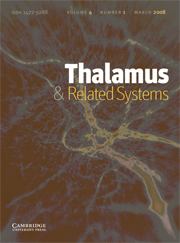No CrossRef data available.
Article contents
Fast oscillations in activated neocortical brain slices: an in vitro continuation of the pioneering in vivo studies of Mircea Steriade and colleagues
Published online by Cambridge University Press: 23 January 2008
Abstract
The seminal in vivo work of Mircea Steriade and his colleagues has, as is always the case with the most insightful and creative scientists, raised many serious questions: questions, for example, of the detailed cellular and molecular mechanisms of the phenomena they discovered. In our tribute to this great investigator, we shall present some examples, based on our in vitro and modeling work, that shed light on some of his remarkable breakthroughs: the slow oscillation of sleep (<1 Hz); the several types of fast oscillations that are superimposed on the intracellular depolarizing, or active, phases of the slow oscillation; and the transition from slow oscillation to seizure via a period of very fast (>70 Hz) oscillations.
- Type
- Review Article
- Information
- Copyright
- Copyright © Cambridge University Press 2008


